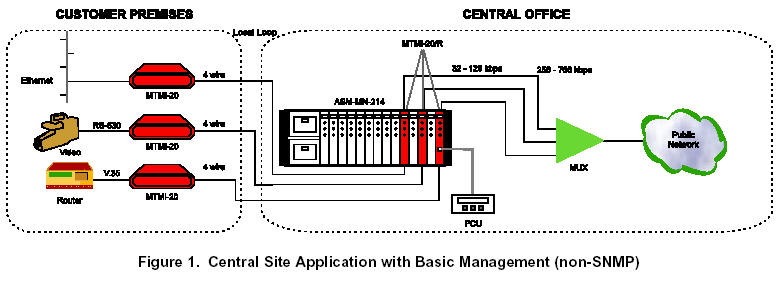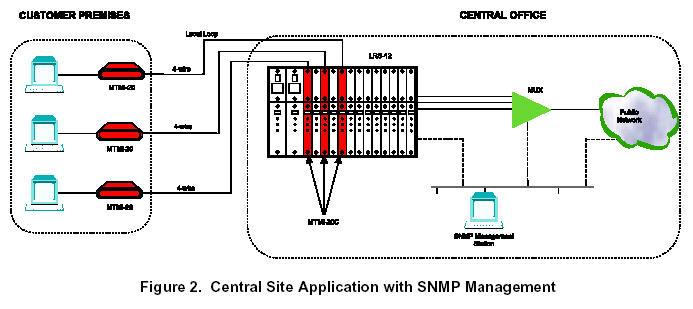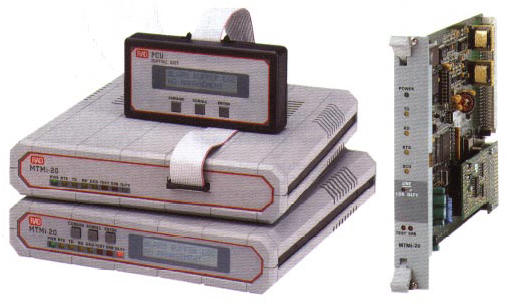|
FEATURES
- MTMi-20 is a synchronous short-range modem,
operating in full duplex over 4-wire lines. Data rates are user-selectable
between 32 kbps and 128 kbps.
- The modem employs QAM technology to extend the
transmission range (see Table 1) and provide efficient transmission, even
over poor quality lines.
- The modem uses an out-of-band management channel
for controlling and monitoring the remote unit. Both data and management
are transmitted over the same wires, simultaneously.
- Menu-driven software, activated from the front
panel, allows the user soft-select monitoring and adjusting of local and
remote units.
The following parameters can be monitored and controlled:
- Baud rate (when set to Internal or Receive mode)
- Clock source
- Output transmit level
- Loop activation
- Internal BER tester activation
- LED status of local and remote units
- Setting both local and remote units to default settings
- Real-time monitoring of link status
- Real-time alerts of fault conditions
- Real-time signal quality monitoring.
- The transmit clock can be derived from three
different selectable sources:
- Internally, from a built-in oscillator
- Recovered from the received signal
- From the digital interface (for tail-end applications).
- When set to external mode, MTMi-20 automatically
detects the clock rate coming from the digital interface and sets the
remote unit to the same rate. When the digital interface rate is changed,
both local and remote units follow the new rate and synchronize
accordingly.
- MTMi-20 supports a wide range of digital
interfaces: V.24/RS-232, V.35, X.21, RS-530, V.36/RS-449 and G.703
codirectional (64 kbps). In addition, an Ethernet/802.3 bridging option
enables direct connection of an Ethernet LAN to both sides of the modems
link.
- The MTMi-20 system configuration is stored in
non-volatile memory, minimizing the system downtime after power is down or
when a faulty remote unit is being replaced.
- The out-of-band management channel provides
real-time alerts for:
- Disconnection of the digital data transmission
- Disconnection of the management channel
- Remote modem failure
- Loop activation.
- Real-time indication of system status is provided
on the front panel LCD for the local and remote modems.
- MTMi-20 is available as a
standalone unit in both
MTMi-20/M "Master" and
MTMi-20/S "Slave" versions. The master version has a front panel LCD and
control switches. The slave unit has a blank panel, which prevents
unauthorized changes of link parameters.
MTMi-20 is also available as a card for central solutions:
- MTMi-20/R - card for the ASM-MN-214 19" modem rack
- MTMi-20C - card for the LRS-12 19" modem rack with central SNMP
management.
- Management of the local and remote modems for
MTMi-20/S and MTMi-20/R versions is carried out via a standalone Portable
Control Unit (PCU) through a special 20-pin connector on the modem front
panel. The PCU is ordered separately (see Ordering).
- The MTMi-20C card for the
LRS-12 rack can be managed from an ASCII terminal or from an SNMP UNIX
station connected to the rack. RADview, an SNMP application, is available
for managing the MTMi-20C cards and other RAD products. RADview enables
management of a large number of links, system infrastructure, and
presentation of statistical information on link availability. It is a
user-friendly system, utilizing a graphical presentation of all network
elements.
- Diagnostic features include activation of ITU V.54
loops and an internal BER tester. The loops available are:
- Local analog loopback
- Local digital loopback
- Remote analog loopback.
- Remote digital loopback
The loops can be activated from the front panel, PCU (Portable Control
Unit) or from the digital interfaces that support loop activation signals.
ORDERING
MTMI-20/CB/V35
MTMI-20/M/115/UTP
MTMI-20/M/115/V24
MTMI-20/M/115/V35
MTMI-20/M/230/V35
MTMI-20/S/115/UTP
MTMI-20/S/115/V24
MTMI-20/S/115/V35
MTMI-20/S/230/V35
APPLICATIONS


|

